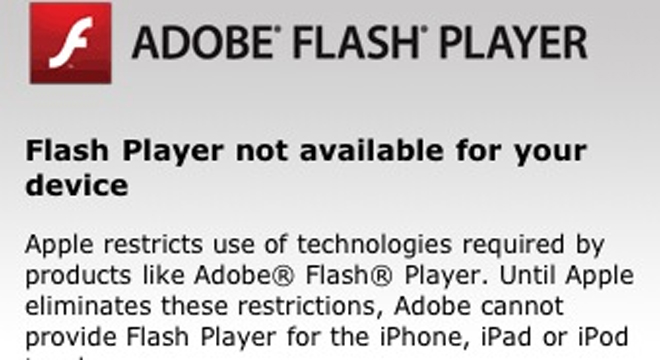Adobe made two paradigm-shifting announcements on Tuesday night, first saying it is laying off 750 full-time employees, nearly 9 percent of its total workforce. The San Jose-based company also revealed that it is will stop adapting its popular Flash web animation software to work on mobile devices such as the Apple iPhone, effectively admitting that former Apple CEO Steve Jobs was right to block Apple mobile devices from supporting Flash.
The first announcement, regarding the layoffs, came in a revised fourth-quarter guidance statement from Adobe in which the company said it was “restructuring its business” to “better align resources around Digital Media and Digital Marketing.”
The company said it believed it would achieve record fourth-quarter revenue within the $1.075 billion to $1.125 billion target range it had previously stated in its third-quarter earnings statement. That said, it also anticipated a lower per-share price of 30 cents to 38 cents a share, instead of the 41 cents to 50 cents-a-share earnings previously forecast, the loss reflecting “restructuring charges.”
It isn’t the first time Adobe has cut such a large share of its workforce. The company laid off about 9 percent in 2009, but that one affected only those employees who moved over from Omniture, which Adobe acquired for $1.8 billion earlier in the year.
Despite this, Adobe has consistently been named one of Fortune magazine’s 100 best companies to work for.
More surprising was Adobe’s candid admission that HTML5 is where the mobile web development trend is headed, not Flash, and as such, the company would be discontinuing its efforts to adapt flash to work on mobile web browsers.
HTML5 is the fifth version of the standard programming language used to create websites, established by the international standards organization the World Wide Web Consortium. Unlike prior versions of HTML, it allows developers the potential to create richer multimedia experiences without resorting to plugins like Flash.
Flash is a multimedia software program from Adobe that allows developers to create animations, movies and games that are embedded in HTML websites, but it requires users to download plugins for their browsers in order to display Flash content.
Adobe’s Flash Player is installed on 98 percent of desktop Web browsers and an estimated 30 to 40 percent of all webpages contained some Flash files, according to a 2008 survey by browser company Opera. Adobe anticipated that Flash would be supported by 250 million smartphones by the end of 2012.
Adobe first let the news of mobile Flash’s demise slip to tech blog ZDNet on Tuesday night, saying in a statement: “We will no longer adapt Flash Player for mobile devices to new browser, OS version or device configurations…We will continue to support the current Android and PlayBook configurations with critical bug fixes and security updates.”
The company expanded upon its brief statement with a lengthier blog post on Wednesday morning. In it, Adobe attempted to bow out of its support for Flash for mobile devices gracefully, taking credit for having helped spur development of rival technology HTML5.
For more than a decade, Flash has enabled the richest content to be created and deployed on the web by reaching beyond what browsers could do. It has repeatedly served as a blueprint for standardizing new technologies in HTML. Over the past two years, we’ve delivered Flash Player for mobile browsers and brought the full expressiveness of the web to many mobile devices. …
However, HTML5 is now universally supported on major mobile devices, in some cases exclusively. This makes HTML5 the best solution for creating and deploying content in the browser across mobile platforms. We are excited about this, and will continue our work with key players in the HTML community, including Google, Apple, Microsoft and RIM, to drive HTML5 innovation they can use to advance their mobile browsers.
That said, the company made clear to ensure that it wasn’t killing Flash entirely, just for mobile devices, explaining that it would continue to be available for desktop Web applications:
We are already working on Flash Player 12 and a new round of exciting features which we expect to again advance what is possible for delivering high definition entertainment experiences. We will continue to leverage our experience with Flash to accelerate our work with the W3C and WebKit to bring similar capabilities to HTML5 as quickly as possible, just as we have done with CSS Shaders. And, we will design new features in Flash for a smooth transition to HTML5 as the standards evolve so developers can confidently invest knowing their skills will continue to be leveraged.
Still, there was little mistaking how the move would and has gone over throughout the tech press, with tech bloggers crowing about how Apple chief Steve Jobs achieved a posthumous victory in standing up to Flash, blocking it from all of Apple’s mobile devices on the basis that it was antiquated technology and a heavy battery-drainer, although rival Google’s Android platform supported it and many Apple users clamored for it.
Jobs’ feud with Flash reached its most dramatic point in April 2010, when the then-Apple CEO published an open letter on the Apple website explaining point-by-point why he was so deadset against Adobe’s technology.
In the letter, Jobs concluded: “Flash was created during the PC era – for PCs and mice. Flash is a successful business for Adobe, and we can understand why they want to push it beyond PCs. But the mobile era is about low power devices, touch interfaces and open web standards – all areas where Flash falls short.”
And although Adobe did finally in September release a version of Flash that would run natively on the iPhone and iPad using the Adobe Flash Media Server 4.5, it is difficult not to see their move away from Flash for mobile as an admission that Apple’s chief was right all along. After all, businesses had conceded that they too were moving away from Flash as a result of the lack of support from Apple devices.
Meanwhile, all those mobile web developers who elected to purchase the latest version, Adobe Flash Professional CS5.5, advertised specifically for the merits of its mobile development capabilities and $119 at its cheapest price, will have to be content with Adobe’s promise to continue to “provide critical bug fixes and security updates for existing device configurations. We will also allow our source code licensees to continue working on and release their own implementations.”
Shares of Adobe were down over 10 percent at the time of this posting.









